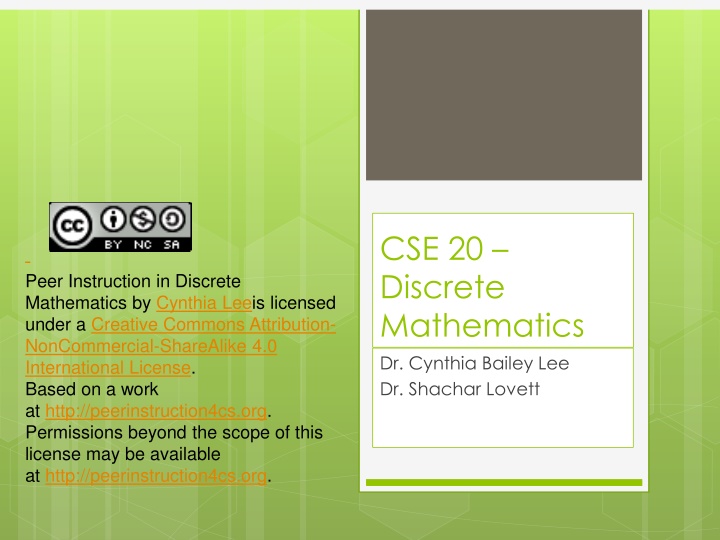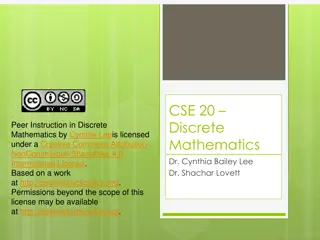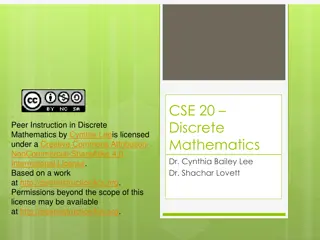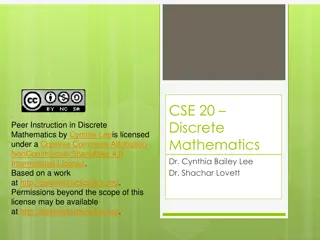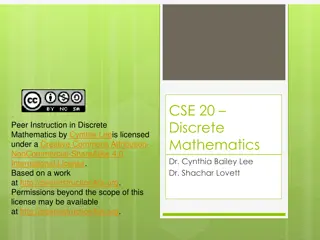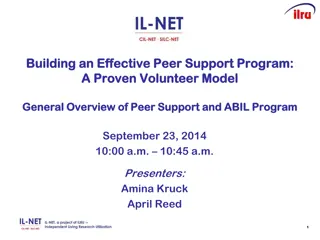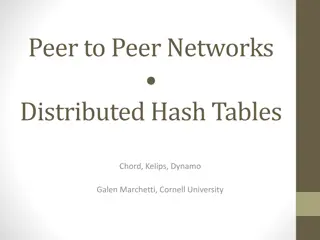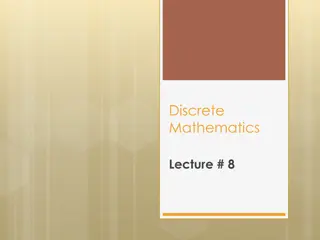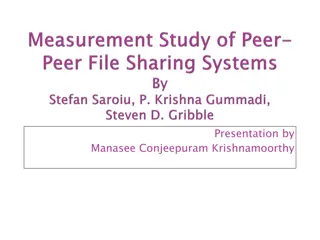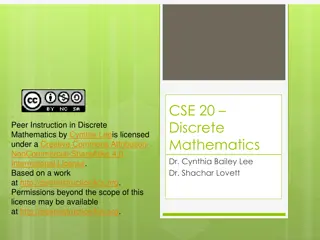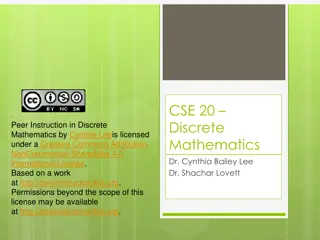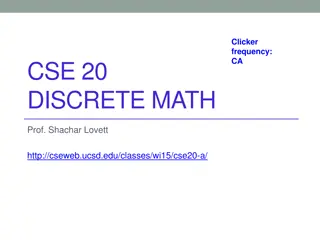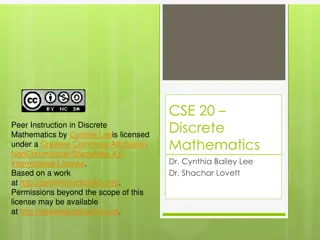Peer Instruction in Discrete Mathematics
The application of mathematical induction with 3-cent and 5-cent examples in discrete mathematics. Understand the theorem that any price over 8 cents can be paid using only 3-cent and 5-cent coins. Follow the basis and inductive steps for proof, illustrated with engaging slides.
Download Presentation

Please find below an Image/Link to download the presentation.
The content on the website is provided AS IS for your information and personal use only. It may not be sold, licensed, or shared on other websites without obtaining consent from the author.If you encounter any issues during the download, it is possible that the publisher has removed the file from their server.
You are allowed to download the files provided on this website for personal or commercial use, subject to the condition that they are used lawfully. All files are the property of their respective owners.
The content on the website is provided AS IS for your information and personal use only. It may not be sold, licensed, or shared on other websites without obtaining consent from the author.
E N D
Presentation Transcript
Creative Commons License CSE 20 Discrete Mathematics Dr. Cynthia Bailey Lee Dr. Shachar Lovett Peer Instruction in Discrete Mathematics by Cynthia Leeis licensed under a Creative Commons Attribution- NonCommercial-ShareAlike 4.0 International License. Based on a work at http://peerinstruction4cs.org. Permissions beyond the scope of this license may be available at http://peerinstruction4cs.org.
2 Today s Topics: 1. Mathematical Induction Proof 3-cents and 5-cents example Our first algorithm!
3 1. Mathematical Induction Proof Examples, examples, examples
4 3-cent and 5-cent coins We will prove the following theorem Theorem: For all prices p >= 8 cents, the price p can be paid using only 5-cent and 3-cent coins 1851-1889 1866-today
5 Thm: For all prices p >= 8 cents, the price p can be paid using only 5-cent and 3-cent coins. Proof (by mathematical induction): Basis step: Show the theorem holds for price p=____. Inductive step: Assume [or Suppose ] that WTS that So the inductive step holds, completing the proof.
6 Thm: For all prices p >= 8 cents, the price p can be paid using only 5-cent and 3-cent coins. Proof (by mathematical induction): Basis step: Show the theorem holds for price p=________. Inductive step: Assume [or Suppose ] that A. 0 cents B. 1 cent C. 2 cents D. 3 cents E. Other/none/more than one WTS that So the inductive step holds, completing the proof.
7 Thm: For all prices p >= 8 cents, the price p can be paid using only 5-cent and 3-cent coins. Proof (by mathematical induction): Basis step: Show the theorem holds for price p=8. Inductive step: Assume [or Suppose ] that WTS that So the inductive step holds, completing the proof.
8 Thm: For all prices p >= 8 cents, the price p can be paid using only 5-cent and 3-cent coins. Proof (by mathematical induction): Basis step: Show the theorem holds for price p=8. Inductive step: Assume [or Suppose ] that A. Theorem is true for p=8. B. Theorem is true for some p>8. C. Theorem is true for some p 8. D. Theorem is true for some p>0. E. Theorem is true for all p>8. WTS that So the inductive step holds, completing the proof.
9 Thm: For all prices p >= 8 cents, the price p can be paid using only 5-cent and 3-cent coins. Proof (by mathematical induction): Basis step: Show the theorem holds for price p=8. Inductive step: Assume [or Suppose ] that theorem is true for some p 8. WTS that So the inductive step holds, completing the proof.
10 Thm: For all prices p >= 8 cents, the price p can be paid using only 5-cent and 3-cent coins. Proof (by mathematical induction): Basis step: Show the theorem holds for price p=8. Inductive step: Assume [or Suppose ] that theorem is true for some p 8. WTS that A. Theorem is true for p=8. B. Theorem is true for some p>8. C. Theorem is true for p+1. D. Theorem is true for p+8. So the inductive step holds, completing the proof.
11 Thm: For all prices p >= 8 cents, the price p can be paid using only 5-cent and 3-cent coins. Proof (by mathematical induction): Basis step: Show the theorem holds for price p=8. Inductive step: Assume [or Suppose ] that theorem is true for some p 8. WTS that theorem is true for price p+1. So the inductive step holds, completing the proof.
12 Thm: For all prices p >= 8 cents, the price p can be paid using only 5-cent and 3-cent coins. Proof (by mathematical induction): Basis step: Show the theorem holds for price p=8. Inductive step: Assume [or Suppose ] that theorem is true for some p 8. WTS that theorem is true for price p+1. ??? So the inductive step holds, completing the proof.
13 3-cent and 5-cent coins Inductive step: Assume price p 8 can be paid using only 3- cent and 5-cent coins. Need to prove that price p+1 can be paid using only 3-cent and 5-cent coints. Main idea: reduce from price p+1 to price p.
14 Making change If we have 100 5-cent coins, and 100 3- cent coins (for a total of p = $8.00), how can we modify the number of 5-cent and 3-cent coins so that we can make the p+1 price (p+1 = $8.01)? A. 40 5-cent coins + 200 3-cent coins 39 5-cent coins + 202 3-cent coins C. 99 5-cent coins + 102 3-cent coins B.
15 Turning our modification scheme into a generic algorithm If we have n 5-cent coins, and m 3-cent coins (for a total of p = 5n+3m), how can we modify the number of 5-cent and 3- cent coins so that we can make the p+1 price (p+1 = 5n+3m+1)? A. n+1 5-cent coins + m-2 3-cent coins n-1 5-cent coins + m+2 3-cent coins C. n+1 5-cent coins + m+2 3-cent coins D. No generic way B.
16 What if we don t have any 5- cent coins to subtract?? If we have 0 5-cent coins, and m 3-cent coins (for a total of p = 3m), how can we modify the number of 5-cent and 3-cent coins so that we can make the p+1 price (p+1 = 3m+1)? A. You can t You can [explain to your group how] B.
17 What if we don t have any 5- cent coins to subtract?? If we have 0 5-cent coins, and m 3-cent coins (for a total of p = 3m), how can we modify the number of 5-cent and 3-cent coins so that we can make the p+1 price (p+1 = 3m+1)? Remove three 3-cent coins, add two 5-cent So: two 5-cent coins, m-3 3-cent points, for a total of 2*5+3*(m-3)=3m+1=p+1
18 That algorithm relies on being able to subtract three 3-cent coins. What if we don t have that many? (only 1 or 2?) A. Uh-oh, our proof can not work as we ve done it so far That could never happen [explain why not] C. That could happen, and we need to make a 3rd (or more) case(s) to handle it B.
19 Thm: For all prices p >= 8 cents, the price p can be paid using only 5-cent and 3-cent coins. Proof (by mathematical induction): Basis step: Show the theorem holds for p=8 (by example, e.g. p=3+5) Inductive step: Assume [or Suppose ] that the theorem holds for some p 8. WTS that the theorem holds for p+1. p 8. Assume that p=5n+3m where n,m 0 are integers. We need to show that p+1=5a+3b for integers a,b 0. Partition to cases: Case I: n 1. In this case, p+1=5*(n-1)+3*(m+2). Case II: m 3. In this case, p+1=5*(n+2)+3*(m-3). Case III: n=0 and m 2. Then p=5n+3m 6 which is a contradiction to p 8. So the inductive step holds, completing the proof.
20 We created an algorithm! Our proof actually allows us to algorithmically find a way to pay p using 3-cent and 5-cent coins Algorithm for price p: start with 8=3+5 For x=8...p, in each step adjust the number of coins according to the modification rules we ve constructed to maintain price x
21 Algorithm pseudo-code PayWithThreeCentsAndFiveCents: Input: price p 8. Output: integers n,m 0 so that p=5n+3m Let x=8, n=1, m=1 (so that x=5n+3m). While x<p: a) x:=x+1 b) If n 1, set n:=n-1, m:=m+2 c) Otherwise, set n:=n+2, m:=m-3 Return (n,m) 1. 2. 3.
22 Algorithm pseudo-code PayWithThreeCentsAndFiveCents: Input: price p 8. Output: integers n,m 0 so that p=5n+3m Let x=8, n=1, m=1 (so that x=5n+3m). 1. While x<p: a) x:=x+1 b) If n 1, set n:=n-1, m:=m+2 c) Otherwise, set n:=n+2, m:=m-3 2. Invariant: x=5n+3m Invariant: x=5n+3m Return (n,m) We proved that n,m 0 in this process always; this is not immediate from the algorithm code 3.
23 Algorithm run example x=8: n=1, m=1 While x<p: a) b) c) 8= Invariant: x=5n+3m x:=x+1 If n 1, set n:=n-1, m:=m+2 Otherwise, set n:=n+2, m:=m-3 9= 10 = 11= 12 =
24 Algorithm properties Theorem: Algorithm uses at most two nickels (i.e n 2) Proof: by induction on p Try to prove it yourself first! x=8: n=1, m=1 While x<p: a) b) c) Invariant: x=5n+3m x:=x+1 If n 1, set n:=n-1, m:=m+2 Otherwise, set n:=n+2, m:=m-3
25 x=8: n=1, m=1 While x<p: a) b) c) Invariant: x=5n+3m x:=x+1 If n 1, set n:=n-1, m:=m+2 Otherwise, set n:=n+2, m:=m-3 Algorithm properties Theorem: Algorithm uses at most two nickels (i.e n 2). Proof: by induction on p Base case: p=8. Algorithm outputs n=m=1. Inductive hypothesis: p=5n+3m where n 2. WTS p+1=5a+3b where a 2. Proof by cases: Case I: n 1. So p+1=5(n-1)+3(m+2) and a=n-1 2. Case II: n=0. So p+1=5*2+3(m-3). a=2. In both cases p+1=5a+3b where a 2. QED
